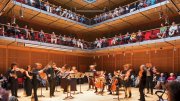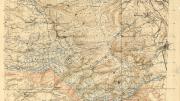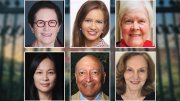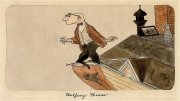In 1996, Weatherhead University Professor Samuel P. Huntington published a provocative and influential book called The Clash of Civilizations and the Remaking of World Order. Huntington, who died last December at the age of 81, argued that with the conclusion of the Cold War, conflicts worldwide would tend toward the cultural rather than ideological. In particular, he warned policymakers to prepare for friction and possible war between Western culture and its antagonists in the East: Chinese culture and Islamic culture. After 9/11, Huntington’s controversial analysis provided an intellectual framework for many in the United States and Europe who viewed Muslims with heightened suspicion. Critics questioned the Clash of Civilizations as simplistic and said it justified illegitimate Western aggression against predominantly Muslim nations, especially in the Middle East.
Christopher Caldwell ’83 adopts Huntington’s thesis and applies it vigorously to the stormy drama of Muslim immigration to Western Europe. A prolific contributor to the Weekly Standard, the Financial Times, and the New York Times Magazine, Caldwell (my Harvard College classmate) shares Huntington’s preference for broad generalization and damn-the-torpedoes argument. Subtle he ain’t.
He colorfully describes a sagging, secular Europe, ashamed of its heritage and inhibited by a reflexive “political correctness” that dictates extreme cultural relativism. Bullying and reshaping this doddering Western civilization, Caldwell contends, is Islam, which--in the person of millions of fertile, devout migrants from Turkey, Algeria, Pakistan, and elsewhere--has launched what amounts to a gradual invasion. Muslims, in his telling, are turning London into a version of Islamabad, Paris into Algiers, and Berlin into Istanbul.
“European countries are shrinking, aging, and short of workers,” Caldwell writes. “Their only obvious supply of rejuvenation and labor is in the Muslim cultures to the south and southeast, which have historically been either Europe’s enemies, its overlords, or its underlings. Europe is wagering that attitudes handed down over the centuries, on both sides, have disappeared, or can be made to disappear. That is probably not a wise wager.”
Forget about assimilation, he admonishes. “Immigration is not enhancing or validating European culture; it is supplanting it.” This he sees as a looming disaster, at least for Europeans.
Caldwell has company in his dire predictions. Bernard Lewis, Princeton’s eminent Islamic scholar, has said that by the end of the twenty-first century, “Europe will be part of the Arabic west, of the Maghreb.” And the numbers are impressive: 20 million Muslims on the continent, if you count the native Muslims of the Balkans. Five million Muslims reside in France, 4 million in Germany, 2 million in Britain. A million Muslims live in London alone, making up an eighth of the city’s population. Large concentrations vie for serious political and social influence in Amsterdam, the suburbs of Paris, and certain neighborhoods of Berlin.
The United States has an immigrant Muslim population of several million, though the precise figure is disputed. (Unlike European countries, the U.S. Census doesn’t do official headcounts by religion.) What’s not contested is that in percentage terms, American Muslims are a much more modest presence than their co-religionists in Britain, France, Germany, or Holland. As Caldwell explains, Europe’s Muslims tend to be poorer, less educated, and less integrated into their host societies. The fundamentalist strain of Islam given to hostile preaching about debauched unbelievers condemned to hellfire (not to mention international Jewish conspiracies) plays a far more prominent role in Muslim communities in Europe than in it does in America.
Terrorism in the name of Islam has been more common in Europe than in the United States, in terms of both consummated acts of violence and nefarious planning. The 9/11 plotters mapped their airborne assault from apartments in Hamburg, Germany. In several instances, bloody violence in Europe has involved second-generation Muslims lashing out at the countries where they were born and raised; the United States has not seen that phenomenon.
Caldwell pays insufficient attention to the variations in ideology among European Muslims, including the secularism of some immigrants who have struggled into the middle class. But he does explain deftly why the European and American stories are so different. After World War II, Europe recruited unskilled labor from predominantly Muslim nations to rebuild war-damaged cities and industries. The host societies lazily and chauvinistically assumed that the imported workers would return to their homelands after a time. Instead, the Muslims settled into ethnic enclaves and brought their relatives. Why not? Europe’s generous welfare systems meant that even when jobs became scarcer, Muslim immigrants could subsist far better in London or Amsterdam than back where they came from.
The United States has enjoyed a more ambitious and, on the whole, more successful breed of Muslim immigrant. Many came to America propelled by middle-class or professional families seeking to send their best and brightest to the States to attend university or to establish small businesses. Demonstrating a drive quite similar to earlier American immigrant groups--Catholics and Jews come to mind--Muslims succeeded in material terms and over time blended into the larger, predominantly Protestant, population. Without Europe’s social safety net, American Muslims had to work hard to get ahead--and they did. The fallout from 9/11 disrupted this classic American immigration narrative, but thankfully hasn’t changed its course in a permanent way.
Even as he draws the U.S.-European comparison, however, Caldwell indulges in a crude rendering of the clash of civilizations idea. In the process, he reveals his weakness as a social critic.
Without sufficient evidence, he suggests that Muslims across the board are a malign force, inherently hostile to the West and incapable of adapting their cultures to those of their host countries. In the case of the United States, Caldwell declares: “The real story of American Muslims is one of accelerating alienation from the mainstream of U.S. life, with Muslims in this country choosing their Islamic identity over their American one.” He cites as support for that conclusion the impression of one notably pessimistic journalist, Geneive Abdo. She blames Western prejudice, a distinction Caldwell glosses over. He similarly ignores a wealth of recent scholarship and polling data that suggest a less gloomy outlook. (Full disclosure: Caldwell also ignores journalism to the contrary, including some committed by your reviewer, so discount--or credit--my view as you see fit.)
Caldwell buttresses his contention that Muslims are a pervasively intimidating presence in Europe by implying that cultural tension leads inexorably to violence. To demonstrate Muslim immigrants’ “dual loyalty,” he repeatedly points to avowed extremists and terrorists, as if their views and actions are typical. He tosses out pejorative labels--Islam is an “adversary culture” and a “blame culture”--with barely any basis. And at times he engages in mischievous logic: noting that Muslim terrorists in the West tend to share a sense of “displacement,” he concludes that “migration, in fact, has a lot to do with terrorism.” But that doesn’t make sense. That some Muslim terrorists in Europe are migrants doesn’t prove that most, or even many, migrants are would-be terrorists.
Europe without a doubt has a Muslim “problem.” In some cities, cultures are in conflict, and the threat of violence hangs in the air. Caldwell correctly calls attention to the origins of this tension, and he offers a chilling preview of where it could lead if moderate-minded leaders do not intervene. But he undercuts his alarm by relying on dubious rhetoric and faulty proof.









